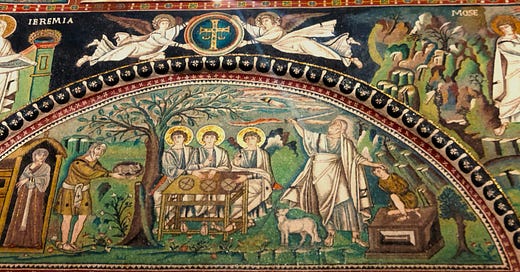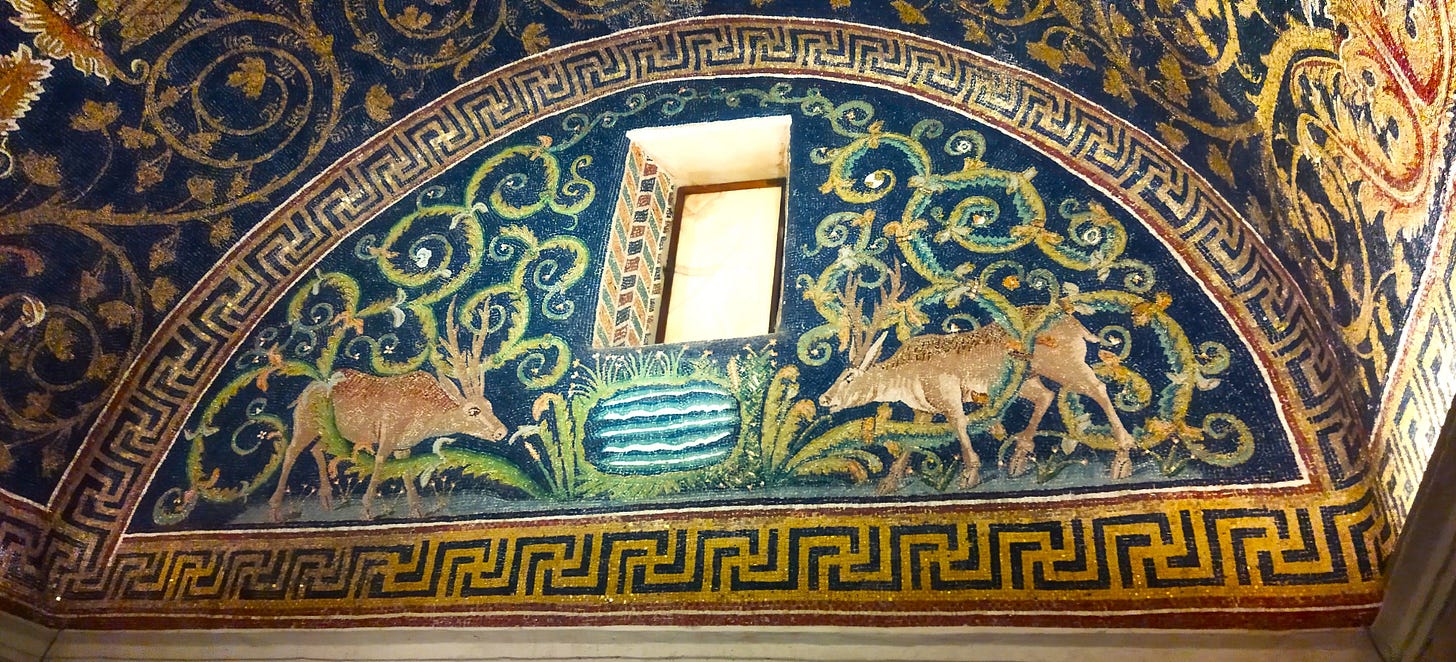Introducing Our First Sacred Images Project Mini-Course: A Civilization Formed in Gold and Stone
Over the past several months, many of you have been following along in our deep dive into the first centuries of Christian art, how it began in hidden places under waves of ferocious and bloody persecution, - quietly expressed in tombs and in the basements of borrowed houses - and then, suddenly, burst fully formed into the public eye with extraordinary confidence. What began as coded symbols carved into stone and painted secretly became, with breathtaking speed, gilded imperial mosaics soaring over great Roman basilicas. This is not just a story about art, it is a story about how the Church came to see itself, and how it learned to make the invisible visible, and finally how that effort formed the foundation of a new civilisation.
In these first centuries, Christians were not simply decorating their worship spaces or marking graves with symbols. They were grappling with profound questions of cosmic import: Who is Christ? What is the Church? How do we represent what we believe, not just with words, but with images, gestures and space itself? As doctrine was revealed by the Holy Ghost, so the Christian visual language, along side the verbal terminology, grew to express it.
To look at the emergence of that visual language of Christian sacred art is to watch the Church come into its own theologically, liturgically and culturally. Art became a vehicle for proclaiming truth, making present what was unseen and establishing a sense of continuity between heaven and earth. In gold, paint and mosaic, the early Christians began to physically and visually manifest the mysteries they celebrated.
This mini-course draws together the most significant points of what we explored during the first quarter of this year, with a more structured approach and focused lens. It is designed for those who want to take a step back and look at the larger arc: how sacred art emerged from hiding, established its visual language, and took on monumental form with imperial patronage, in the post-persecution era.
How The Mini-Course Works
Our courses will include original footage like this I took at Ravenna in February
One module = one post to the new “Courses” section of the site. Each module will be an overview of material already covered in articles on the site, so there’s totally a cheat-sheet right there.
Paid members will receive each new lesson in their inbox and can access the full archive anytime.
Each post includes a downloadable PDF version (text + images), ideal for printing or keeping in a study folder.
Each module post will also include supplementary videos - original and linked to external sources on YouTube and the like, links to further reading, a book list and a short section of essay prompts and reflection questions, ideal for homeschoolers, self-paced study, or group discussion.
You’ll also receive: A visual timeline handout, glossary of sacred art terms and a suggested reading list
NB: These materials are available only to paid subscribers.
Not a paid subscriber? The PDFs will also be available as a package for individual purchase via our Ko-fi shop.
Whether you follow along as the course is published or return to it at your own pace, everything will be available in one place, the “Courses” tab on the top of the main page.
What the 1st Quarter Course Covers
The course is divided into six short modules, each focusing on a distinct stage of development:
What Is Sacred Art?
Definitions, metaphysics, and visual theology; how Christian art is more than decoration.Underground Beginnings: Art in the Catacombs
Secret symbols, tomb art, and the transformation of domestic spaces into sacred ones.The Turning Point: Constantine and the Edict of Milan
Legalisation, patronage, and the birth of public Christian art and architecture.Establishing a Visual Language
The rise of prototypes, frontal figures, halos, and gold; and the influence of the wider Mediterranean world.The Icon Is Born
Theology after Chalcedon, monastic patronage, and why the icon is not “just art.”What We’ve Learned and Where We’re Going
A synthesis of these foundational centuries and a look ahead to what’s coming next.
Who The Course Is For
Readers curious about the roots of Christian art
Homeschoolers, auto-didacts or students looking for a guided path through early Church history and Christian sacred aesthetics
Artists, catechists, or clergy wanting to understand the deeper meaning behind what we see in sacred imagery
Anyone who senses that sacred art is not just beautiful, but important and wants to know why
When It Starts
The first module will go live on Monday, April 14, with new modules following on a regular schedule, weekly after Easter week. Paid subscribers will receive PDF downloads and supplementary materials by email.
Not yet a paid member? You can upgrade your subscription here to get the full course and all resources, including PDFs and access to the full archive of posts.
Not a member yet? You can join us for just $9/month.
At The Sacred Images Project we explore Christian life, thought, history, and culture through the lens of the first 1200 years of sacred art.
This is a reader-supported publication, which means:
No ads
No pop-ups
No sponsored nonsense
This is my full-time work, and while it now provides a sustainable income, we’re building something much larger: a multi-layered, multimedia hub for the renewal of sacred beauty.
You can subscribe for free to receive one post per week.
Paid subscribers receive:
A second, weekly in-depth post on Christian art and tradition
Access to the full archive
Exclusive videos, photo essays, printable resources, and more
In the works: eBooks, mini-courses, podcasts, and video lectures.
Please Share
The more people rediscover the depth and meaning of sacred art, the better.







Thank you Hilary, this will be great!